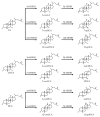Interactive Relationships between Intestinal Flora and Bile Acids
- PMID: 35955473
- PMCID: PMC9368770
- DOI: 10.3390/ijms23158343
Interactive Relationships between Intestinal Flora and Bile Acids
Abstract
The digestive tract is replete with complex and diverse microbial communities that are important for the regulation of multiple pathophysiological processes in humans and animals, particularly those involved in the maintenance of intestinal homeostasis, immunity, inflammation, and tumorigenesis. The diversity of bile acids is a result of the joint efforts of host and intestinal microflora. There is a bidirectional relationship between the microbial community of the intestinal tract and bile acids in that, while the microbial flora tightly modulates the metabolism and synthesis of bile acids, the bile acid pool and composition affect the diversity and the homeostasis of the intestinal flora. Homeostatic imbalances of bile acid and intestinal flora systems may lead to the development of a variety of diseases, such as inflammatory bowel disease (IBD), colorectal cancer (CRC), hepatocellular carcinoma (HCC), type 2 diabetes (T2DM), and polycystic ovary syndrome (PCOS). The interactions between bile acids and intestinal flora may be (in)directly involved in the pathogenesis of these diseases.
Keywords: bile acids; diseases; homeostatic imbalances; interactions; intestinal flora.
Conflict of interest statement
The authors declare no conflict of interest.
Figures




Similar articles
-
Lactobacillus brevis alleviates the progress of hepatocellular carcinoma and type 2 diabetes in mice model via interplay of gut microflora, bile acid and NOTCH 1 signaling.Front Immunol. 2023 May 10;14:1179014. doi: 10.3389/fimmu.2023.1179014. eCollection 2023. Front Immunol. 2023. PMID: 37234174 Free PMC article.
-
Gut microbiota-derived bile acids in intestinal immunity, inflammation, and tumorigenesis.Cell Host Microbe. 2022 Mar 9;30(3):289-300. doi: 10.1016/j.chom.2022.02.004. Cell Host Microbe. 2022. PMID: 35271802 Free PMC article. Review.
-
[The intestinal microflora and cholestatic liver diseases].Zhonghua Gan Zang Bing Za Zhi. 2019 May 20;27(5):325-329. doi: 10.3760/cma.j.issn.1007-3418.2019.05.002. Zhonghua Gan Zang Bing Za Zhi. 2019. PMID: 31177655 Chinese.
-
Bile Acid-Gut Microbiota Axis in Inflammatory Bowel Disease: From Bench to Bedside.Nutrients. 2021 Sep 9;13(9):3143. doi: 10.3390/nu13093143. Nutrients. 2021. PMID: 34579027 Free PMC article. Review.
-
Bile acids and their receptors: Potential therapeutic targets in inflammatory bowel disease.World J Gastroenterol. 2023 Jul 21;29(27):4252-4270. doi: 10.3748/wjg.v29.i27.4252. World J Gastroenterol. 2023. PMID: 37545642 Free PMC article. Review.
Cited by
-
Addition of soluble fiber to standard purified diets is important for gut morphology in mice.Sci Rep. 2023 Nov 7;13(1):19340. doi: 10.1038/s41598-023-46331-5. Sci Rep. 2023. PMID: 37935741 Free PMC article.
-
The Gut Microbiota-Related Antihyperglycemic Effect of Metformin.Pharmaceuticals (Basel). 2025 Jan 6;18(1):55. doi: 10.3390/ph18010055. Pharmaceuticals (Basel). 2025. PMID: 39861118 Free PMC article. Review.
-
The oral-gut microbiome axis in inflammatory bowel disease: from inside to insight.Front Immunol. 2024 Jul 26;15:1430001. doi: 10.3389/fimmu.2024.1430001. eCollection 2024. Front Immunol. 2024. PMID: 39131163 Free PMC article. Review.
-
Gut commensals and their metabolites in health and disease.Front Microbiol. 2023 Nov 8;14:1244293. doi: 10.3389/fmicb.2023.1244293. eCollection 2023. Front Microbiol. 2023. PMID: 38029089 Free PMC article. Review.
-
Dry ginger and Schisandra chinensis modulate intestinal flora and bile acid metabolism to treatment asthma.Front Microbiol. 2025 Mar 27;16:1541335. doi: 10.3389/fmicb.2025.1541335. eCollection 2025. Front Microbiol. 2025. PMID: 40212383 Free PMC article.
References
Publication types
MeSH terms
Substances
Grants and funding
LinkOut - more resources
Full Text Sources
Medical

